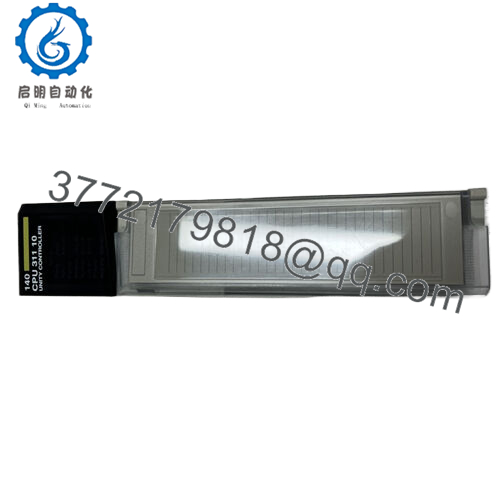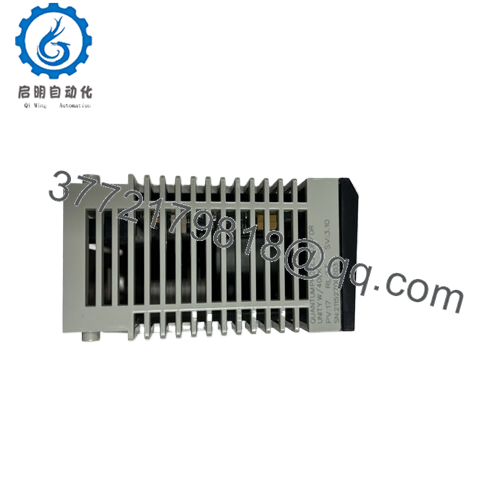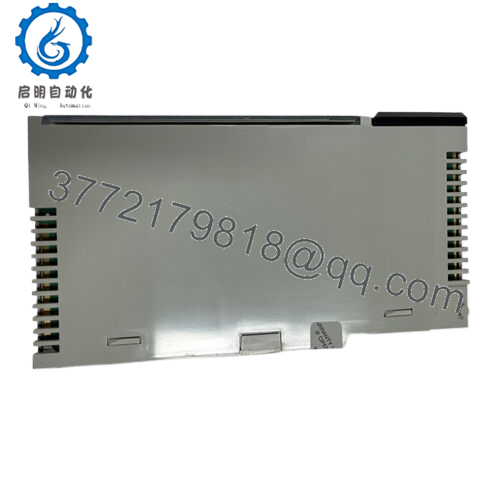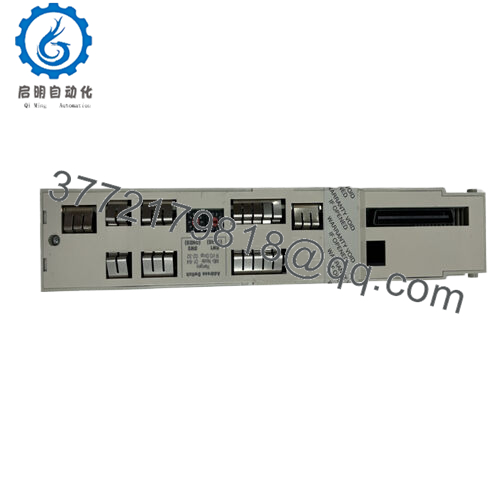Description
Product Model: 140CPU31110
- Product Brand: Schneider Electric
- Product Series: Modicon Quantum / Unity
- Product Features:
• 66 MHz Unity processor with 548 kB internal RAM
• Supports up to 10 local slots, distributed I/O via Modbus Plus, and remote I/O via S908 racks
• Application-level features: high-speed interrupts, accurate time stamping, counters, serial link
• Flexible communications: multiple optional modules (Ethernet, Modbus, Modbus Plus, Profibus DP, Sy/Max)
Technical Features & Benefits
The 140CPU31110 is a Unity-class CPU in the Modicon Quantum family, designed for mid-to-large automation tasks. It operates with a 66 MHz clock speed, offering solid performance for control logic, diagnostics, and communication tasks. Its internal RAM is 548 kB, which supports user logic, data storage, and system overhead.
This CPU supports robust application services: high-speed interrupt inputs, accurate time stamping, counter functionality, and embedded serial link interface capabilities. In internal benchmarking, instruction execution times range (for Boolean, floating-point, arithmetic) between roughly 0.1 to 0.27 µs depending on operation type.
From a system perspective, the 140CPU31110 supports up to 10 local slots (though the rack may support up to 27 total slots in some architectures) for mixing I/O and communication modules. It can manage distributed I/O via Modbus Plus networks (63 stations per network) and remote I/O through S908 remote racks, with remote I/O capacity of up to 31,744 discrete inputs and outputs.
In terms of communications, the CPU has built-in support for Modbus Plus, Modbus (RS-232/485/ASCII), and space for optional modules such as Ethernet, Profibus DP, or Sy/Max. The front panel includes a slide switch setup for communication port mapping (ASCII/RTU/Memory) and memory port enabling.
The 140CPU31110 draws approximately 1,800 mA from the backplane bus. It includes standard LED indicators: “RUN,” “READY,” “BAT LOW,” “ERROR (Modbus Plus)” among others, enabling quick diagnostics on status and health.
Because this CPU is part of the mature Quantum line, its design and protocols are well supported in the field, and many integrators value its balance between capability and proven reliability.
Product Role & System Fit
The 140CPU31110 functions as the central processing unit within the Quantum / Unity architecture. It runs logic, coordinates I/O scanning, and handles communication with field devices and supervisory systems. In many installations it sits at the heart of a control rack, connected to I/O, comm modules, and remote I/O networks.
Within a rack, the CPU typically occupies the “CPU slot,” with I/O and communication modules surrounding it. Because it supports local, distributed, and remote I/O, it serves both small local control loops and more extensive system-wide integration. For example, local digital and analog modules plug directly into the same rack, while distant stations communicate over Modbus Plus or remote racks.
In expansions, you might add Ethernet or fieldbus modules alongside 140CPU31110 to bridge to SCADA, DCS, or MES layers. It’s often used in retrofit or hybrid systems where legacy Quantum racks remain while newer communication paths are added.
If you migrate gradually, you can leave 140CPU31110 in place and swap communication modules or interface bridges without disturbing logic. Its feature set offers enough headroom for many mid-sized control applications.
Applications & Industry Context
In plants where process continuity, safety, and reliability matter—such as water treatment, power generation, pulp & paper, chemical processing, and industrial infrastructure—the 140CPU31110 is often a go-to choice. Because it supports reliable field communications and I/O scalability, it’s well suited for process and discrete control systems.
For example, in a wastewater treatment facility, you might use 140CPU31110 to manage pumps, sensors, dosing valves, level controllers, and alarms. Remote booster stations could be connected via distributed racks or remote I/O, all coordinated by the same CPU. Its time-stamping and interrupt features help with capturing fast events like fault signals or alarms.
In paper mills or pulp lines, when high-speed count or event tracking is needed (web breaks, encoder pulses, wrapper faults), the CPU’s interrupt capabilities let it respond to events without waiting for slow scan cycles.
OEM equipment (packaging lines, material handling) sometimes rely on the 140CPU31110 when system performance needs exceed smaller CPUs, but full redundancy is not required. Its flexibility and compatibility make it a stable choice in long-life machinery.
Because many facilities still operate Quantum systems, spares and refurb units of 140CPU31110 remain in circulation. Its long presence in the field gives engineers confidence in its reliability and serviceability.
Installation & Maintenance Insights
From hands-on experience, here are tips for installing and maintaining 140CPU31110:
- Ventilation & Cooling: Maintain ambient rack temperatures within specification (0–60 °C typical) and avoid placing hot modules adjacent to the CPU.
- Slot Planning: Place communication modules (e.g. Ethernet, Modbus Plus) next to the CPU slot to minimize trace delays and cabling complexity.
- Firmware & Program Backups: Always back up your ladder logic, configuration, and module settings before firmware updates or module swaps.
- LED Monitoring: Check “RUN,” “READY,” and bus activity LEDs during commissioning. A blinking “ERROR (Modbus Plus)” LED often points to bus mismatch or wiring issues.
- Test Remote Networks: Before going live, simulate remote rack failures or Modbus Plus link failures and observe how the system reacts.
- Battery Care: The CPU has a battery for memory retention; when the “BAT LOW” LED glows, schedule battery replacement to avoid logic loss.
- Spare Matching: Given age, maintain a spare 140CPU31110 (same revision, firmware) and keep your wiring and network maps handy for rapid swap-in.
- Avoid Hot-swapping: Insert or remove the CPU only when power is off; avoid module insertion under power unless the architecture explicitly supports it.
- Periodic Checks: Inspect connector seating, tightness of wiring blocks, and signs of corrosion or heat discoloration during planned shutdowns.
A practical trick: bring a laptop with programming software (Unity or relevant Schneider tools) to field start-up. Use it to verify CPU configuration, communication responses, and module presence before powering up full load.
- 140CPU31110
Technical Specifications Table
| Specification | Value / Detail |
|---|---|
| Module Type | Unity Processor (Modicon Quantum) |
| Clock Frequency | 66 MHz |
| Internal RAM | 548 kB |
| Local Slots Supported | 10 local slots |
| Distributed I/O Support | Up to 63 stations via Modbus Plus |
| Remote I/O Support | Up to 31,744 discrete IO via remote S908 racks |
| Discrete I/O Capacity | 8,000 inputs / 8,000 outputs (distributed) |
| Analog I/O Capacity | 500 inputs / 500 outputs (distributed) |
| Application I/O | High-speed interrupts, counters, time stamping, serial link |
| Optional Modules | Ethernet, Profibus DP, Sy/Max, Modbus, etc. (2 optional module slots) |
| Backplane Current Draw | ~1,800 mA |
| LED Indicators | RUN, READY, ERROR, BAT LOW, etc. |
| Communications | Modbus Plus, Modbus (RS232/485), optional Ethernet, Profibus DP, Sy/Max |
| Integrated Connectors | SUB-D 9 connectors for Modbus Plus, 2 SUB-D 9 for Modbus, USB port |
| Operating Temp | Standard industrial (0–60 °C in typical installations) (implied by standard Quantum spec) |
| Mounting / Rack | Fits Quantum backplane / rack system (supports up to 2 local racks) |
| Documentation Standard | Complies with Schneider’s Quantum / Unity processor architecture |





 WhatsApp: +86 16626708626
WhatsApp: +86 16626708626 Email:
Email:  Phone: +86 16626708626
Phone: +86 16626708626


